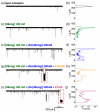Probing the Hepatitis B Virus E-Antigen with a Nanopore Sensor Based on Collisional Events Analysis
- PMID: 36004992
- PMCID: PMC9405897
- DOI: 10.3390/bios12080596
Probing the Hepatitis B Virus E-Antigen with a Nanopore Sensor Based on Collisional Events Analysis
Abstract
Real-time monitoring, simple operation, and cheaper methods for detecting immunological proteins hold the potential for a solid influence on proteomics and human biology, as they can promote the onset of timely diagnoses and adequate treatment protocols. In this work we present an exploratory study suggesting the applicability of resistive-pulse sensing technology in conjunction with the α-hemolysin (α-HL) protein nanopore, for the detection of the chronic hepatitis B virus (HBV) e-antigen (HBeAg). In this approach, the recognition between HBeAg and a purified monoclonal hepatitis B e antibody (Ab(HBeAg)) was detected via transient ionic current spikes generated by partial occlusions of the α-HL nanopore by protein aggregates electrophoretically driven toward the nanopore's vestibule entrance. Despite the steric hindrance precluding antigen, antibody, or antigen-antibody complex capture inside the nanopore, their stochastic bumping with the nanopore generated clear transient blockade events. The subsequent analysis suggested the detection of protein subpopulations in solution, rendering the approach a potentially valuable label-free platform for the sensitive, submicromolar-scale screening of HBeAg targets.
Keywords: antigen; electrophysiology; hepatitis B; monoclonal antibody; nanopore; single molecule detection.
Conflict of interest statement
The authors declare no conflict of interest.
Figures






Similar articles
-
Nanoscale Probing of Informational Polymers with Nanopores. Applications to Amyloidogenic Fragments, Peptides, and DNA-PNA Hybrids.Acc Chem Res. 2019 Jan 15;52(1):267-276. doi: 10.1021/acs.accounts.8b00565. Epub 2019 Jan 3. Acc Chem Res. 2019. PMID: 30605305
-
Unzipping Mechanism of Free and Polyarginine-Conjugated DNA-PNA Duplexes, Preconfined Inside the α-Hemolysin Nanopore.Anal Chem. 2020 Jun 2;92(11):7800-7807. doi: 10.1021/acs.analchem.0c00976. Epub 2020 May 19. Anal Chem. 2020. PMID: 32367708
-
Specific determination of hepatitis B e antigen by antibodies targeting precore unique epitope facilitates clinical diagnosis and drug evaluation against hepatitis B virus infection.Emerg Microbes Infect. 2021 Dec;10(1):37-50. doi: 10.1080/22221751.2020.1862631. Emerg Microbes Infect. 2021. PMID: 33296295 Free PMC article.
-
Diagnosis and management of pre-core mutant chronic hepatitis B.J Viral Hepat. 2001 Sep;8(5):311-21. doi: 10.1046/j.1365-2893.2001.00303.x. J Viral Hepat. 2001. PMID: 11555188 Review.
-
Nanopore sensors for viral particle quantification: current progress and future prospects.Bioengineered. 2021 Dec;12(2):9189-9215. doi: 10.1080/21655979.2021.1995991. Bioengineered. 2021. PMID: 34709987 Free PMC article. Review.
Cited by
-
Single molecule technique unveils the role of electrostatic interactions in ssDNA-gp32 molecular complex stability.RSC Adv. 2024 Feb 13;14(8):5449-5460. doi: 10.1039/d3ra07746b. eCollection 2024 Feb 7. RSC Adv. 2024. PMID: 38352678 Free PMC article.
References
MeSH terms
Substances
Grants and funding
LinkOut - more resources
Full Text Sources

